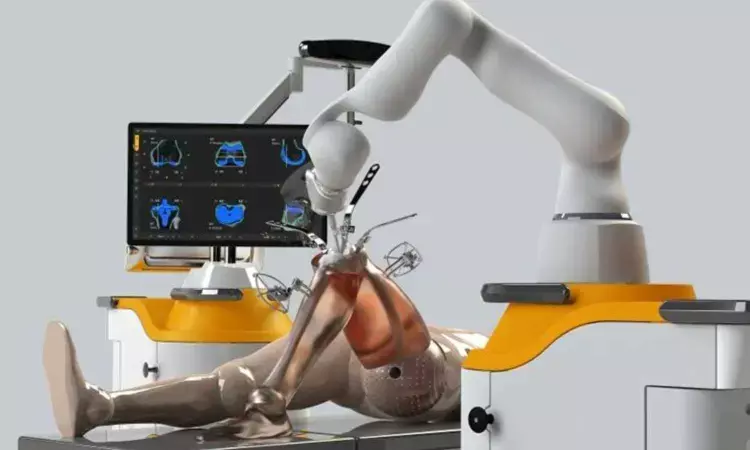- Home
- Medical news & Guidelines
- Anesthesiology
- Cardiology and CTVS
- Critical Care
- Dentistry
- Dermatology
- Diabetes and Endocrinology
- ENT
- Gastroenterology
- Medicine
- Nephrology
- Neurology
- Obstretics-Gynaecology
- Oncology
- Ophthalmology
- Orthopaedics
- Pediatrics-Neonatology
- Psychiatry
- Pulmonology
- Radiology
- Surgery
- Urology
- Laboratory Medicine
- Diet
- Nursing
- Paramedical
- Physiotherapy
- Health news
- Fact Check
- Bone Health Fact Check
- Brain Health Fact Check
- Cancer Related Fact Check
- Child Care Fact Check
- Dental and oral health fact check
- Diabetes and metabolic health fact check
- Diet and Nutrition Fact Check
- Eye and ENT Care Fact Check
- Fitness fact check
- Gut health fact check
- Heart health fact check
- Kidney health fact check
- Medical education fact check
- Men's health fact check
- Respiratory fact check
- Skin and hair care fact check
- Vaccine and Immunization fact check
- Women's health fact check
- AYUSH
- State News
- Andaman and Nicobar Islands
- Andhra Pradesh
- Arunachal Pradesh
- Assam
- Bihar
- Chandigarh
- Chattisgarh
- Dadra and Nagar Haveli
- Daman and Diu
- Delhi
- Goa
- Gujarat
- Haryana
- Himachal Pradesh
- Jammu & Kashmir
- Jharkhand
- Karnataka
- Kerala
- Ladakh
- Lakshadweep
- Madhya Pradesh
- Maharashtra
- Manipur
- Meghalaya
- Mizoram
- Nagaland
- Odisha
- Puducherry
- Punjab
- Rajasthan
- Sikkim
- Tamil Nadu
- Telangana
- Tripura
- Uttar Pradesh
- Uttrakhand
- West Bengal
- Medical Education
- Industry
Robotic Innovations in Orthopedics

The perspective "Robotic Innovations in Orthopedics: A Growing Landscape, Challenges, and Implications for Care" by Robin Hu et al in 'Osteology journal' explores the evolution and future trajectory of robotic technologies in orthopedic surgery.
1992 ROBODOC, 2006 MAKO & PIGALILEO,
2007 DA VINCI, 2010 OMNIBOTICS,
2012 NAVIO, 2016 TSOLUTION ONE,
2017 EXCELCIUS GPS, 2018 MAZOR X STEALTH,
2019 ROSA SPINE, 2020 VELYS,
2021 ROSA HIP, 2022 ROSA KNEE.
Robotics have significantly enhanced surgical precision, efficiency, and clinical outcomes, with early innovations such as ROBODOC, Mako, and ACROBOT paving the way for more advanced systems like Navio, ROSA, TSolution One, and VELYS. These systems have expanded beyond joint arthroplasty to include applications in spinal surgery and orthopedic trauma, contributing to the rise of minimally invasive procedures and improved patient recovery times.
Future developments are centered around the integration of artificial intelligence (AI), augmented reality (AR), and personalized medicine. AI is anticipated to optimize preoperative planning and intraoperative decision-making, while AR promises to enhance surgical navigation and rehabilitation outcomes. Innovations in patient-specific instrumentation (PSI) and personalized implants aim to improve procedural accuracy and implant longevity. Additionally, advances in remote and autonomous surgery, including telesurgical applications, are expected to increase access to specialized orthopedic care globally. Robotic rehabilitation devices are also emerging as critical tools for enhancing post-operative recovery through precise, real-time therapy.
Despite these advancements, significant challenges persist. High costs, extensive training requirements, regulatory hurdles, cybersecurity concerns, and ethical considerations regarding patient consent and data security are notable barriers to widespread adoption. Financial accessibility remains a concern, particularly in resource-limited settings, prompting suggestions for alternative financing models such as leasing, shared-use agreements, and government grants.
Current evidence regarding the long-term superiority of robotic-assisted orthopedic procedures over conventional methods remains inconclusive. While early studies demonstrate improved precision and reduced complication rates, definitive long-term benefits have not been universally established. As such, the justification for the high capital investment in robotic systems must be based on clear evidence of clinical and economic value.
In conclusion, while robotics holds considerable promise to transform orthopedic care through enhanced precision, personalization, and accessibility, thoughtful, evidence-based implementation is essential. Ongoing research, cost-benefit analyses, and strategic integration into clinical practice will be critical to realizing the full potential of robotic technologies in orthopedics.
Further reading:
Robotic Innovations in Orthopedics: A Growing Landscape, Challenges, and Implications for Care Robin Hu et al Osteology 2025, 5, 13 https://doi.org/10.3390/osteology5020013
MBBS, Dip. Ortho, DNB ortho, MNAMS
Dr Supreeth D R (MBBS, Dip. Ortho, DNB ortho, MNAMS) is a practicing orthopedician with interest in medical research and publishing articles. He completed MBBS from mysore medical college, dip ortho from Trivandrum medical college and sec. DNB from Manipal Hospital, Bengaluru. He has expirence of 7years in the field of orthopedics. He has presented scientific papers & posters in various state, national and international conferences. His interest in writing articles lead the way to join medical dialogues. He can be contacted at editorial@medicaldialogues.in.


